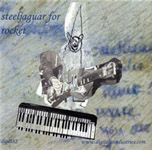|
|
 |
Dusted Reviews
Artist: Tom Carter & Robert Horton Album: Steeljaguar for Rocket Label: Digitalis Review date: May. 29, 2007 |

|
|
|
 |
On paper, a duo with Robert Horton and Tom Carter seems a strange pairing. Whereas Horton is known for his eccentric homemade instruments and shifting, multi-faceted sound environments, Carter has built a career out of single monolithic chords and droning tones. The pair, however, possesses much common ground. Both have been fixtures of the American sub-underground, cutting-and-pasting the maps of noise, improvisation, Americana, drone and psychedelia, and, most importantly, both have an urge to destabilize, atomize and mutate their sound. It’s this urge that made last year’s Lunar Eclipse a success, and Steeljaguar for Rocket continues the run.
Steeljaguar consists of three tracks, the 30-minute title piece and two shorter excursions. All three traverse the pair’s respective musical geographies, sometimes all at once - an all-inclusive grab that results in maximal music overload. The title piece breaks down into roughly three parts: an opening drift of organ-like hum, blinkering guitar chords, damaged leads and scattered drums peaks into a jocular psychedelic boogie, rounded out by an extended outro of drone led by the violin of guest Hal Hughes. The multiple days listed for recording suggest improvisations culled and collaged into a cohesive whole, an a priori composition that highlights the pair’s strengths and reins in the indulgence inherent in both musicians’ approaches.
The remaining tracks compress the strategy of the title track into more combustible units. The hard-driving, unstable energy of free jazz drumming and overblown sax on “Rocket #9” makes for a drone of considerable heft. They push peak intensity for the duration, even in the drumless middle section, when Carter’s guitar fuses with Horton’s slide boot (one of his self-made instruments) and bass. If “Rocket #9” establishes the summit, album closer “Launching Pad at Pooneil Corners” chases the energy of decay. Squalling feedback, stinging sine waves and other sonic debris circle and implode on each other, soundtracking an imaginary supernova. The whole cools and condenses into a low-intensity drone backed by bass and brushed drums. Even at its most dense, Steeljaguar hits the sweet spot between composition and improvisation.
By Matthew Wuethrich
|







